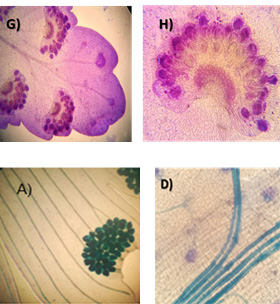Standardization of the plant diaphanization process; of Adiantum pedantum L. (Pteridaceae), Nephrolepis exaltata (L.) Schott (Nephrolepidaceae) and one Spermatophyta Pyracantha koidzumii Hayata Rehder (Rosaceae)</i>
DOI:
https://doi.org/10.18387/polibotanica.60.5Keywords:
Diaphanization, histology, dyes, plant tissue, clarify.Abstract
Plant diaphanization is a technique that allows to distinguish the various types of plant architecture, however has been undertilizated due to the complications presented during previous techniques, such the 5-5-5 technique of (Arambarri, 2018). The aims of this work were: Standardize the diaphanization technique 5,5,5, in the genera Nepholepis, Adantium, and Pirachanta; and compare different dyes. As preliminary tests, flowers, leaves, stems of 7 different genera were analyzed, and finally the leaves of ferns of the genus Nephrolepis and Adiantum as well as stems, leaves of Pyracantha were selected. The 5-5-5 clarification technique (Arambarri, 2018) was taken as a reference, reducing the exposure time of the clarifying solution material to optimize the absorption of dyes. Six dyes and two combinations were selected. By using toluidine blue (AT), TS, ST, methylene blue (AM) and crystal violet (GV), the vascular tissue, sori, sporangia could be observed in the pinnae of the fern, spores and stomata. It was identified that the diaphanization time varies depending on the tissue, several structures were differentiated from the use of the 6 dyes. It was possible to optimize time and cost and design protocols to perform this process in species of botanical interest.
References
Armiñana R J, & Breijo G F. (2006). Técnicas de histología vegetal (Vol. 16). Jardín Botánico de Valencia.
Dizeo de Strittmatter C G. (1973). Nueva Técnica de Diafanización. Boletín de La Sociedad Argentina de Botánica, XV(1), 126–129.
Megias M, Molist P, & A. Pombal M. (2020). Tejidos vegetales vasculares (Departamento de Biología Funcional y Ciencias de la Salud., Ed.; Vol. 5). Facultad de Biología. Universidad de Vigo. https://mmegias.webs.uvigo.es/descargas/v-conduccion.pdf
Rodriguez R I S, & Romero R S. (2007). Arquitectura foliar de diez especies de encino (Quercus, Fagaceae) de México. Acta Botánica Mexicana. https://www.scielo.org.mx/scielo.php?pid=S0187-71512007000400002&script=sci_abstract&tlng=es
Sandoval, D., Tellez J, Rivera G, Moreno S, & Moreno F. (2017). Técnica de diafanización para describir el desarrollo embrionario del sistema óseo. Revisión de la literatura. Universitas Médica, 57(4), 488–501. https://doi.org/10.11144/JAVERIANA.UMED57-4.TDDD
Tejero D J D, Aguilar R S, Terrazas T, & Pacheco L. (2010). Arquitectura y anatomía foliar del complejo Polypodium plesiosorum sensu Moran (Polypodiaceae). Revista de Biología Tropical, 58(3), 955–976. http://www.scielo.sa.cr/scielo.php?script=sci_arttext&pid=S0034-77442010000300012&lng=en&nrm=iso&tlng=es
Valencia A S. (2014). Introducción a las embriofitas. Dirección General de Publicaciones y Fomento Editorial UNAM. https://books.google.es/books?hl=es&lr=&id=1wqnDwAAQBAJ&oi=fnd&pg=PA6&dq=introduccion+a+las+embriofitas&ots=XF6ei5dbwq&sig=orn7dMRnVWRAE_odCu2DYc92nQM#v=onepage&q=introduccion%20a%20las%20embriofitas&f=false

Downloads
Published
License
Copyright (c) 2025 POLIBOTANICA

This work is licensed under a Creative Commons Attribution-NonCommercial-ShareAlike 4.0 International License.

Polibotánica by Departamento de Botánica de la Escuela Nacional de Ciencias Biológicas del Instituto Politécnico Nacional se distribuye bajo una Licencia Creative Commons Atribución-NoComercial-CompartirIgual 4.0 Internacional.



















